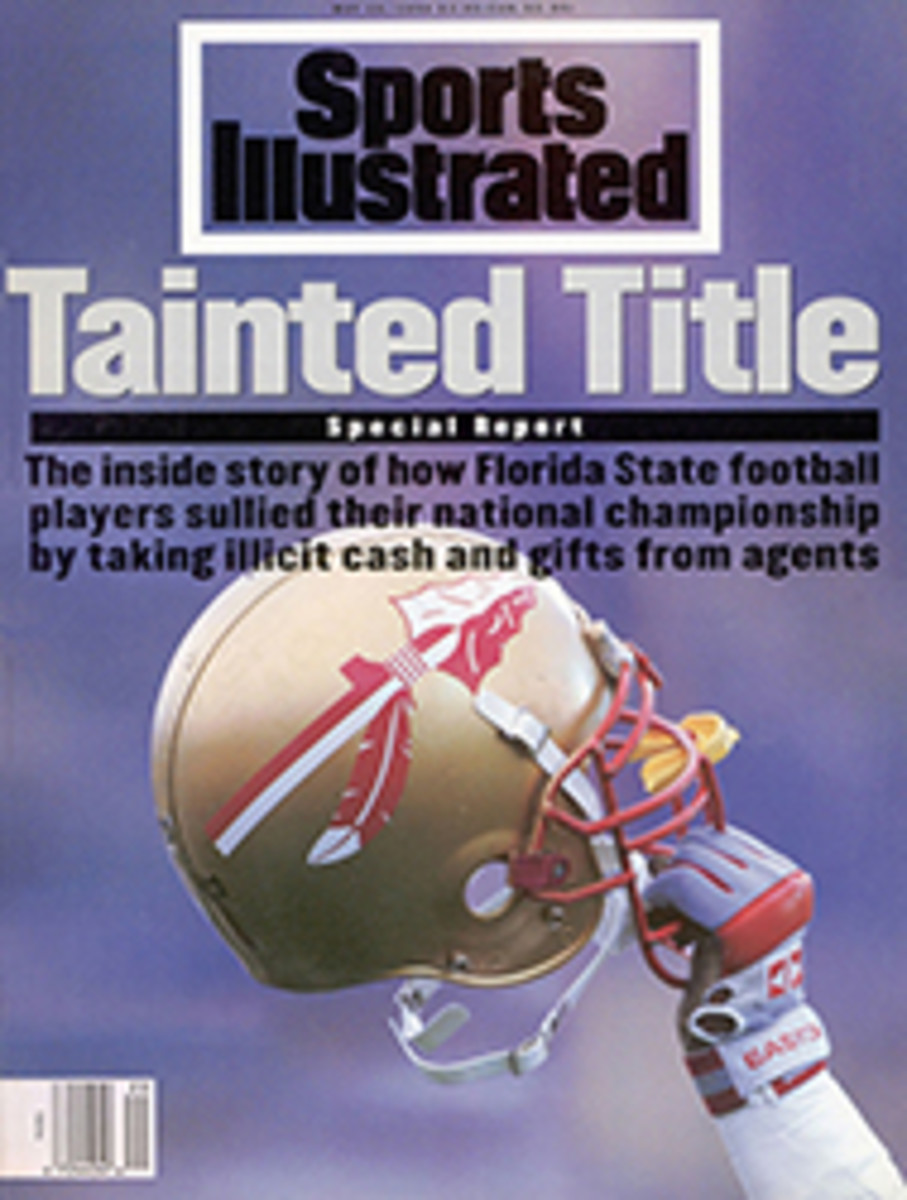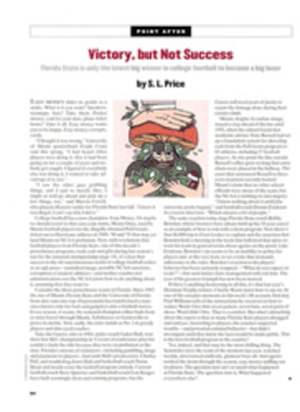
Part Dash, Part Bash
A hash run. Hmmm. Sounds like a bit of weirdness dreamed up in Haight-Ash-bury during the '60s. A few hippies were sitting around their pad eating funny brownies, and one space cowboy got hit by a cosmic lightning bolt: "Hey-y-y, like let's tie-dye our sneakers and run backward from the Golden Gate Bridge to that town in Minnesota where Dylan was born. Can you dig it?"
Hashing, actually, happens to be a strictly legal, nonpsychedelic athletic endeavor. Not that it can't take a toll on the brain. Think of the sport as part frat party, part connect-the-dots; as a synergistic activity, one that has struck a chord with Michele Brock of Arlington, Va. "I used to drink beer, and I used to run," says Brock, a human resources consultant and a veteran of about 60 hashes, "but I had never done both at the same time, so hashing has definitely changed my perspective on exercise."
Hash runs vary from locale to locale. Some runs are family-oriented. Some—the more traditional beer-soaked hashes—are just plain disorienting. But all hash runs feature a designated "hare" who lays out a meandering, five-or six-mile cross-country course, and a gang of 30 to 100 fellow runners who pay a few dollars apiece to experience the thrill of blindly following the route from start to finish. The hare marks the trail with a series of baking-flour splotches or bits of shredded paper, often hiding the indicator at, say, the base of a fire hydrant or the far side of an out-of-the-way tree. Numerous false trails are included to liven up the proceedings. These white herrings can wind along for a quarter mile or more before ending abruptly in a floury X".
Hash trails are limited only by the imagination of the hare. They may wander through fields and streams, suburban neighborhoods, department stores, subway stations or giant storm drains. Over hill, over dale, over Chippendale. One creative hare even laid his trail through the main reading room of the Library of Congress. Wherever the marks lead, hashers stick to them like baying bloodhounds, communicating in a peculiar verbal shorthand. Slow runners continually bellow, "Are you?" (As in "Are you folks up ahead still hot on the trail?") The query brings one of two replies from those faster afoot: either the sweet sound of "On, on!" or "Checking!" (The former means "Continue on, full speed ahead"; the latter is the equivalent of a pause button, which, while it depends on the circumstances, usually translates as "We think we got suckered onto a false trail.")
When everyone has finally found the cold beer and the snickering rabbit at trail's end, by-the-book hashers like to conclude the running festivities by herding everyone into a circle and toasting the hare of the day.
About the only hash rule that is taken seriously is the one that forbids taking hashing seriously. "The whole idea behind the false trail is to get the front-runners to run back to where the pack is," says Marty Hanratty, 50, a normally respectable federal bureaucrat who has been hashing for nearly 20 years. "The best run is no longer than one hour. The front-runners finish in 50 minutes, and the last runners come in within the hour, so there's no more than 10 minutes' difference between the times."
According to the World Hash Handbook and Directory, there are nearly 1,100 hash clubs worldwide, including one in Antarctica and one in Tonga. A three-or four-day Interhash is held every other year and draws as many as 1,000 participants from around the globe. The next get-together will be in Cyprus in 1996.
The U.S. has approximately 200 hash clubs, with a dozen in the Washington, D.C., area alone. Hash groups tend to have distinctive personalities, which run the gamut from sedate to manic. In Washington the White House Hash House Harriers—who count Hanratty among their regulars—have no connection with the White House, other than a firm conviction that the burger-loving jogger currently in residence would make a splendid hasher. The White House hashers bill themselves as "the drinking club with a running problem" and have an affinity for bawdy sing-alongs. The Mount Vernon (Va.) Hashers, on the other hand, are as reserved and purposeful as General Washington himself. They tend to conduct their runs at near warp speed. The Hash House Harriettes and Harriers fall somewhere in the middle on the geniality scale, while the Washington Men's Hash—the oldest hash in the country, with more than 1,000 weekly runs under its belt since 1972—doesn't much cotton to outsiders.
Members of the U.S. military and diplomatic corps living overseas are hard-core hashing enthusiasts. When traveling abroad, you can count on the British, Australian and American embassy staffs to point you toward the closest hash. This is fitting, because hashing has expatriate roots. It was started in 1938 as a lark by bored British soldiers and civil servants stationed in Kuala Lumpur, Malaysia. A military chap by the name of Albert Stephen Gispert, reportedly drawing inspiration from the English children's game hare and hounds, is credited with being the Abner Doubleday of hashing. In theory, the Malaysian hash, which was held on Monday night, was a pleasant way to work off calories accumulated during a weekend of overindulgence. In practice, the hash became another excuse to knock back a few pints with the boys.
There are three creation myths behind the naming of the game hash. One holds that the mess hall at the British military base in Kuala Lumpur was dubbed the Hash House. Yet it is also said that the lads used to drink a postrun snootful at a local hangout called Harry's Hash House. The third story is that Malaysian street vendors used to chase after the runners, peddling bowls of noodles known as hash. Regardless of its etymology, hashing flourished while the British colonial empire dwindled away.
What makes the sport so appealing? Mari Clark, an anthropologist with the Development Technologies company in Washington and a sometime hasher, observes that "in a workaholic city," hashing is "a major stress-reduction thing." Han-ratty speaks of friendships formed by shared "participation in something physical." He notes with pride that back in his hashing days in Jakarta, from 1983 to '88, "We had a colonel from the Indonesian police department who used to run with us, and a couple of Indonesian doctors. We had the local KGB person, British and American people, and some Japanese."
Without too much trouble a diehard hasher could hash-hop around the world, sampling exotic runs the way baseball fanatics seek out unusual stadiums. The Jakarta hash that Hanratty frequented had a $60,000-a-year budget, which provided for a beer truck to dispense cold brews after runs. In Bahrain, false trails have reportedly been marked with dead camels. John Studach, a stalwart White House Hash House Harrier, has fond memories of a goofy hash that wound through the backwoods of Waukesha, Wis. "In the middle of nowhere," he recalls, "there was a woman with a desk and chair. She was giving sexual advice to the hashers."
John Epple, who formed the White House Hash House Harriers in 1987 and holds the group's title of religious adviser for life, sells medical supplies to other countries and travels frequently. One day a few years ago Epple ran a hash in Indonesia and then hopped a plane to Australia that very night. Upon landing in Sydney, he telephoned a hash contact he knew only by her hashing nickname and inquired about the local run.
"She said, 'I'll pick you up at six,' and I went hashin' that night," Epple says triumphantly. "When you start hashin', the world does become a kind of small place. It gives you an instant network in a city. And hashers like other hashers."
Gabra George, a teacher, is in the process of finding that out. He shows up at Studach's house in northwest Washington on a muggy night in early summer. It is Studach's turn to play hare, and some 40 of the faithful are gathered in his backyard awaiting the 7 o'clock hash start.
George, a reserved 36-year-old Egyptian emigrant and onetime "local table tennis champion" in Cairo, was invited to Studach's by a friend who hashes. Before the night is over, George will huff and puff his way through thigh-high brambles and through thickets of poison ivy. At times he will pirouette madly in place, gazing high and low in hope of glimpsing a spot of flour. He will hot-step across two creeks and fall neck-deep into a third. Afterward, he'll turn bug-eyed while chugging a mug of beer in the company of five other hash virgins.
But those delights are yet to come. Right now the White House hashers are busy loosening up with a few preliminary beers while Studach reminisces about the three Dutch Marines who rode tricycles into a fellow hasher's swimming pool.
The White House Hash House Harriers drift into the front yard to perform what amounts to a parody of stretching exercises. They flail their arms wildly. They shake their legs. They sing nonsensical songs off-key. One hasher has on a black top hat. Another wears a multicolored beanie with a propeller on top. George surveys the scene. He thinks he's glad his friend invited him along.
"He told me it was a running experience," George says softly, feeling the first sudden rush of enlightenment, as unmistakable as an ice-cold beer poured down his back. "I am discovering now there's something different about it."
TWO ILLUSTRATIONS
JESSIE HARTLAND
Tom Dunkel is a free-lance writer who is based in Washington, D.C.

